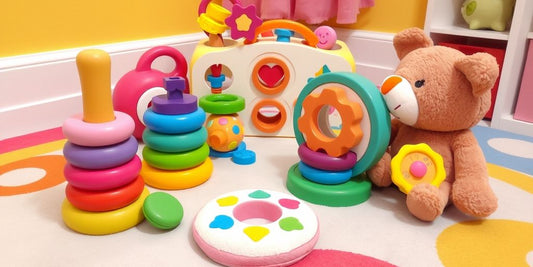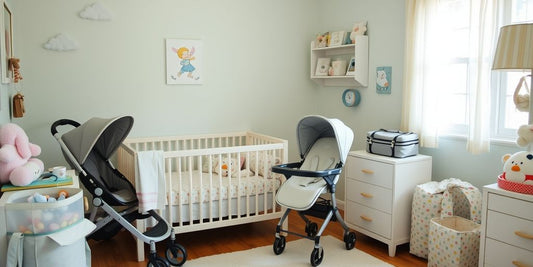Watching your baby go through teething can be tough. Those little gums can cause a lot of discomfort. But don't worry! This guide will help you recognize the signs of teething and offer some effective ways to soothe your baby's pain. From home remedies to safe teething toys, we've got you covered.
Key Takeaways
- Recognize the signs of teething early to help your baby feel better sooner.
- Simple home remedies like a cool washcloth or chilled fruits can provide relief.
- Create a comforting environment with warm baths and lots of cuddles.
- Choose safe teething toys and avoid frozen remedies to protect your baby's gums.
- Consult a healthcare provider for severe discomfort, fever, or diarrhea.
Recognizing the Signs of Teething
Common Symptoms to Watch For
Teething can be a challenging time for both babies and parents. Recognizing the signs early can help you provide the right comfort. Some common symptoms include:
- Swollen or tender gums
- Increased drooling
- Chewing on objects or hands
- Fussiness or irritability
- Red or flushed cheeks
- Rubbing their ear
When Teething Starts
Most babies begin teething between 4 to 12 months old. However, it can vary widely. Some infants might start earlier, while others may not show signs until later.
How Long Teething Lasts
The teething process can be lengthy. Typically, it starts around 6 months and continues until all 20 baby teeth have emerged, usually by age 3. Each tooth can cause discomfort for a few days before it breaks through the gumline.
It's important to note that fever, diarrhea, and rashes are not normal symptoms of teething. If your baby shows these signs, consult a healthcare provider.
Effective Home Remedies for Teething Pain
Using a Cool Washcloth
A simple and effective remedy is to use a cool washcloth. Dampen a clean washcloth, wring it out, and place it in the fridge for a while. Once it's cool, let your baby chew on it. The cold helps to numb the gums and reduce inflammation.
Chilled Fruits and Vegetables
Introduce your baby to chilled fruits and vegetables. You can offer them chilled mashed bananas, applesauce, or even a refrigerated carrot. These not only provide relief but also serve as a tasty snack. Always supervise your baby to avoid choking hazards.
Cool Metal Spoon
A cool metal spoon can also be a great tool. Place a small metal spoon in the fridge and once it's cool, gently rub the curved side against your baby's gums. This can provide immediate relief from teething pain.
Remember, teething is a natural process, and while it can be uncomfortable, these home remedies can help soothe your baby's discomfort effectively.
Creating a Comforting Environment
Warm, Soothing Baths
A warm bath can be incredibly calming for a teething baby. The warm water helps to relax their muscles and can distract them from the discomfort in their gums. Adding a few drops of lavender oil to the bath can enhance the soothing effect, making it easier for your baby to settle down for the night.
Lots of Cuddles
Sometimes, all your baby needs is a little extra love and attention. Holding and cuddling your baby can provide the comfort they need during this challenging time. The close contact not only reassures them but also helps to distract from the pain. Remember, your touch is one of the most powerful tools you have.
Using Soft Bibs for Drool Management
Teething often comes with a lot of drooling, which can lead to skin irritation. Using soft, absorbent bibs can help keep your baby's skin dry and prevent rashes. Look for bibs made from gentle materials that won't irritate their sensitive skin. Keeping a few extra bibs on hand can make it easier to manage the drool throughout the day.
Safe Teething Toys and Tools

Choosing the Right Teething Toys
When selecting teething toys, it's crucial to ensure they are BPA-free and easy to clean. Opt for toys made from natural materials like unfinished wooden teethers. For a really safe, non-toxic teether, get a U.S.-made unfinished wooden teether. We like the Camden Rose wooden teether. You'll pay a reasonable $10-$15, but you can be assured of its safety.
Benefits of Teething Rings
Teething rings are a classic choice for soothing teething discomfort. Chilling a teething ring or a damp washcloth (not frozen) can provide additional relief to sore gums. The cold temperature reduces inflammation and temporarily numbs the pain. Always ensure the item is clean and not too cold to prevent any harm to your baby's sensitive gums.
Avoiding Frozen Remedies
While it might be tempting to use frozen items to soothe your baby's gums, it's best to avoid them. Frozen remedies can be too harsh and may cause more harm than good. Instead, stick to chilled items that are cool but not icy. This approach ensures your baby's comfort without risking damage to their delicate gums.
When to Consult a Healthcare Provider
Teething is a natural part of a baby's growth, but sometimes it can cause more serious issues. Knowing when to seek help from a healthcare provider is important for your baby's well-being.
Establishing a Dental Hygiene Routine

Brushing After Feedings
Start brushing your baby’s teeth after meals and snacks to prevent plaque build-up. Use only a smear of non-toxic baby toothpaste, using a baby-sized toothbrush. Leftover food can cause cavities, and the natural sugar in breast milk and formula can attract bacteria.
Choosing the Right Toothbrush and Toothpaste
When your baby’s teeth start to come through, you can clean them with a toothbrush. Make sure the toothbrush has:
- a small head
- a large handle
- soft bristles
Alternatively, you can use a finger toothbrush which fits around your finger while cleaning your baby's mouth and teeth. A finger toothbrush can give you more control than a normal toothbrush, making the cleaning process easier.
Avoiding Cavities Early On
To prevent cavities, never send your baby to bed with a bottle. This can lead to baby bottle tooth decay. Consistent brushing routines become ingrained behaviors, making it easier for your child to maintain healthy teeth throughout their lives. Wipe your baby's gums with a clean cloth 2 times a day before they get any teeth. Once your child is older, help them develop a dental hygiene routine that will stick through their toddler years and beyond.
Conclusion
Teething can be a challenging time for both babies and parents, but with the right strategies, you can help your little one feel more comfortable. From using cool washcloths and metal spoons to giving lots of cuddles and managing drool, there are many ways to soothe your baby's sore gums. Remember to consult your healthcare provider for advice on baby teething medicine if needed. As your baby starts to show off their new teeth, it's also important to begin a dental hygiene routine to keep those tiny teeth healthy. If you have any concerns or questions, don't hesitate to reach out to your healthcare provider. Soon enough, your baby will be smiling with a mouth full of adorable teeth!
Frequently Asked Questions
What are the first signs of teething?
Common signs of teething include drooling, swollen gums, and a desire to chew on hard objects. Your baby might also be crankier than usual.
When do babies usually start teething?
Most babies begin teething around 6 months old, but some can start as early as 4 months or as late as 12 months.
How long does the teething process last?
Teething can last a few months to a couple of years, typically ending by the time your child is around 2 to 3 years old when they have a full set of baby teeth.
What home remedies can help soothe teething pain?
You can use a cool washcloth, chilled fruits and vegetables, or a cool metal spoon to help soothe your baby's sore gums.
When should I consult a healthcare provider about my baby’s teething?
If your baby shows signs of severe discomfort, has a fever, or experiences diarrhea, it's best to consult a healthcare provider. These symptoms might not be related to teething.
How can I establish a dental hygiene routine for my teething baby?
Start by brushing your baby's gums and emerging teeth after feedings with a soft-bristled toothbrush and baby-safe toothpaste. Avoid letting your baby fall asleep with a bottle to prevent cavities.









